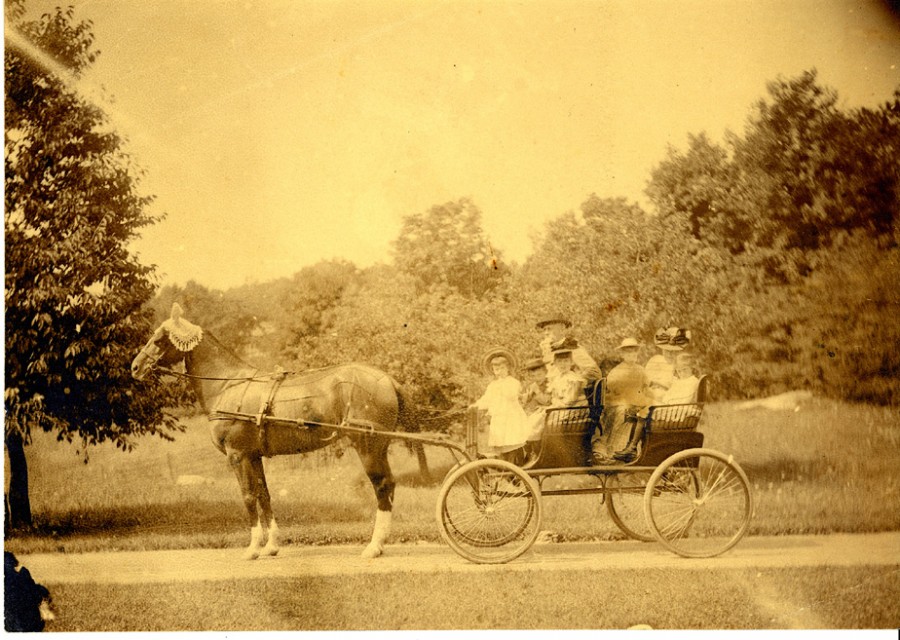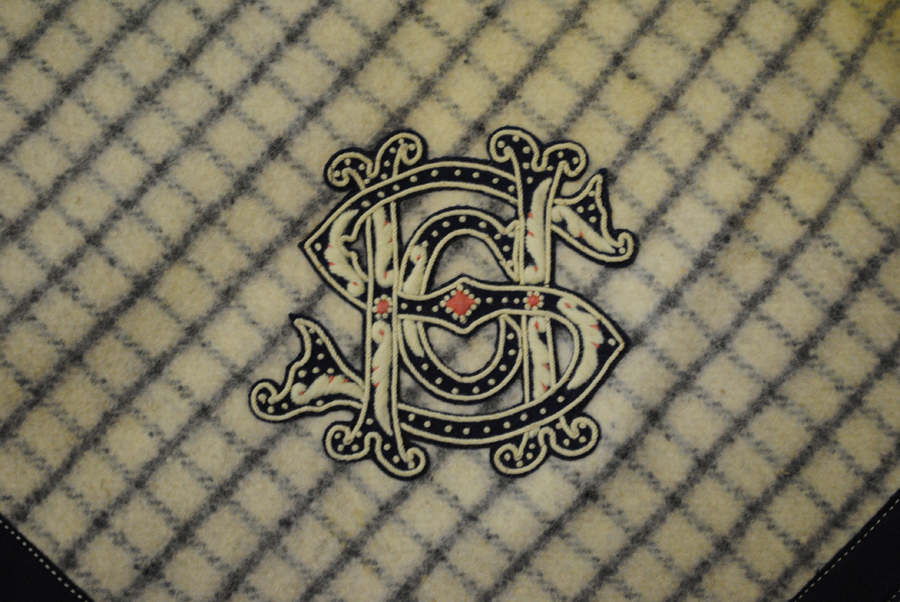Meet the Hewitts: Part Four described the Hewitts going to Gilded Age balls and their love of fashion and entertaining. This month let’s enjoy their country lifestyle at Ringwood Manor.
Sue Shutte, Historian at Ringwood Manor
Margery Masinter, Trustee, Cooper-Hewitt, National Design Museum
Life at Ringwood Manor
When people think of Gilded Age summer estates, seldom does New Jersey come to mind. But that is exactly where the Cooper and Hewitt families established their retreat. The 22,000-acre Ringwood property was breathtaking in the nineteenth century. Situated in the heart of the Ramapo Mountains in the northeastern part of the state, the rolling hillsides, forests, streams, and lakes made the property idyllic. The site provided the bucolic and stress-free setting the family was looking for and it was a mere hour’s train ride from New York City.

The Abram S. Hewitt Estate, by artist Martha Wood Belcher c. 1865, showing the landscape at Ringwood Manor. Ringwood Manor collection.

The young Hewitt family in carriage on Ringwood property, c. 1868. Courtesy of Cooper Union Library.
The property Peter Cooper purchased in 1853 was still primarily used as an iron mining company, but his daughter saw more. In 1855, the newly wed Sarah Amelia traveled to Ringwood and promptly fell in love with the area, working quickly to establish the family’s country residence. A small home already existed, but it was not large enough for the Hewitts, their extended family, and a large circle of friends and visitors. Additions to Ringwood Manor brought the rambling Victorian structure to a total of 51 rooms. Edward once wrote that if his mother had lived to be 100 years old, Ringwood Manor would be 100 feet longer! The Hewitt family’s coat of arms, designed with an owl and the Latin motto "Tam Nocte Quam Die Sapire," meaning “Wise Both Night and Day,” was featured throughout Ringwood.

Front view of Ringwood Manor, c. 1936. Ringwood Manor collection.

Interior of the Great Hallway. Note the mounted Buffalo head, a gift of houseguest Buffalo Bill when he visited in July of 1894. Ringwood Manor collection.

Details of the owl symbol used throughout Ringwood Manor: (from left to right) fireplace surround, detail of wall sconce, uniform livery buttons.
Sarah Amelia spent as much time developing the gardens and grounds at Ringwood Manor as she did the home itself. She said that she could not paint a picture, but she could create one. Her love of landscape and garden design rubbed off on her daughter, Eleanor. The two women laid out formal gardens behind the home, even damming a river to form a lake as a focal feature, later known as “Sally’s Pond.” Elizabeth Duer wrote in 1902 that there was “[a] mysterious charm about the pleasure-grounds of Ringwood. You can find surroundings to fit every mood.”

A color-tinted image of the Italian sunken garden at Ringwood Garden, c. 1910. Ringwood Manor collection.

Detail of an early landscape plan for Ringwood Manor, c. 1865. Ringwood Manor collection.

Letter from Francis Hoppin to Eleanor Hewitt discussing a book on landscape and garden design they had intended on authoring together, 1897. Ringwood Manor collection.
The Hewitt children participated in a wonderful array of outdoor activities and projects at Ringwood. As accomplished equestrians, Sarah and Eleanor were appropriately attired in fashionable riding habits. They eventually ran the enormous Ringwood estate, directing both household matters and the farming and gardening operations. Vegetables and diary grown and produced on the estate had a reputation for outstanding quality. These were sold at the Ringwood grocery in New York City. (An early example of local farm to city table!)

Sarah on horseback, ca. 1880. Courtesy of Cooper Union Library.

Sarah’s monogrammed horse blanket. Courtesy of The Henry Ford Museum.

Eleanor’s riding ensemble, with skirt, jodhpurs and knee-high gaiters. ca. 1896. Courtesy of the Metropolitan Museum of Art Costume Institute; Gift of the Princess Viggo.

Newspaper article about Sarah and her involvement with Ringwood farm products being sold in New York City. Courtesy of Cooper Union Library.
The Ringwood guestbooks have become treasured documents of many visitors to the estate. They feature signatures, poems, cartoons, and drawings from a veritable “who’s who” of prominent figures– including politicians, authors, inventors, and entertainers. There are hundreds of pages in the four books dating from 1876-1884; 1884-1890; 1891-1902; and 1902-1932, and, luckily, they have been carefully preserved.

Page from 1876-1884 Guestbook; Page from 1884-1890 Guestbook.

Page from 1891-1902 Guestbook; Page from 1902-1932 Guestbook.
In 1938, Erskine Hewitt donated Ringwood Manor and its surrounding property to the State of New Jersey for use as a museum and a state park. The site was declared a National Historic Landmark District in 1976. It is currently administered by Ringwood State Park and the New Jersey Division of Parks and Forestry. Ringwood Manor is open to the public for guided tours throughout the year. Thirty of the 51 rooms, complete with their original furnishings, are available to see. Information regarding tours and events at Ringwood Manor, along with history of the site, can be found by visiting www.ringwoodmanor.org
Interactive Timeline of the Cooper Hewitt World
Full timeline is available here.
Sources:
Duer, Elizabeth. "Ringwood Manor and Its Gardens," House & Garden Magazine, Philadelphia, PA. September, 1902, Vol. II, No. 9, pages 398-409.
Hewitt, Edward Ringwood. Ringwood Manor, Home of the Hewitts. Trenton Printing Company, Trenton, NJ: 1946.
Hewitt, Erskine. The Forges and Manor of Ringwood: 1935. Privately Printed, New York: 1935.
Nevins, Allan. Abram S. Hewitt. Harper & Brothers, New York: 1935
"Miss S.C. Hewitt Elected on a School Board," New York Times, March 23, 1899.
"A Lady of the Old School," New York Times, October 18, 1930.
